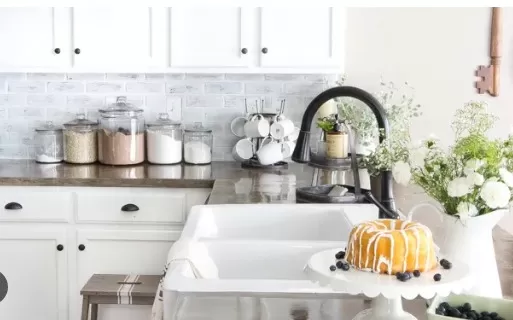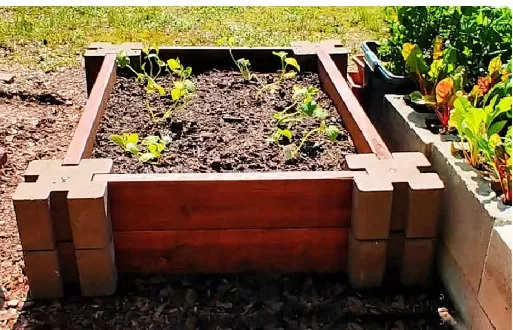Easy DIY Home Projects for All Abilities. Don’t let the thought of making practical and stylish changes to your home intimidate you! You’ll be surprised to know that these DIY home projects are designed to be simple enough for anyone to tackle.
Whether you’re a seasoned DIY enthusiast or just starting out, you can confidently take on these projects and bring a fresh touch to your living space. From small improvements to larger transformations, these projects are accessible and achievable for all skill levels. So roll up your sleeves and get ready to create a more practical and stylish home with these DIY endeavors.
Transform Your Space: Wallpapering a Wall for Color and Texture

If you’re looking to add color, pattern, and texture to your room in a way that paint alone can’t achieve, wallpaper is the perfect solution.
With a wide range of materials and designs available, wallpaper allows you to create an elegant and invigorating atmosphere in your space. Today’s prepasted papers make the process of applying wallpaper much easier, even for DIY enthusiasts.
By following a few simple steps and considering key measurements, you can successfully wallpaper a wall and bring a new dimension to your home decor. In this section, we’ll guide you through the process, from measuring your wall to selecting the right amount of wallpaper and ensuring a seamless application.
Get ready to transform your space and create a stunning feature wall that reflects your personal style.
Embrace Sustainable Living: Creating Your Own Compost
Composting is a simple and effective way to reduce waste, divert materials from landfills, and improve the quality of your soil.
By turning organic materials into nutrient-rich compost, you can contribute to a healthier environment and create a valuable resource for your garden or plants. It’s a sustainable habit that anyone can adopt, and it’s easy to get started. In this section, we’ll guide you through the process of creating your own compost, from knowing what can and can’t be composted to achieving the right balance of materials and maintaining the compost pile. By following these steps, you’ll be well on your way to producing nutrient-rich compost and making a positive impact on the planet. Let’s dive in and discover the wonders of composting.
Step 1: Understand What Can and Can’t Be Composted: To ensure successful composting, it’s important to know what materials can be included in your compost pile.
Suitable items for composting include fruits, vegetables, coffee grounds, dryer lint, shredded newspaper, grass clippings, and small leaves and twigs. However, it’s crucial to avoid adding meat or dairy products, as they can attract pests and slow down the composting process.
Step 2: Achieve the Right Balance: To create optimal conditions for composting, aim for a ratio of three parts brown material (such as leaves, twigs, and other carbon-rich materials) to one part green material (kitchen scraps and nitrogen-rich materials).
This balance ensures proper decomposition and helps prevent any unpleasant odors. Remember to chop or shred larger materials to speed up the breakdown process.
Step 3: Choose an Ideal Location: Find a warm, sunny spot in your yard or garden to place your compost pile or bin.
The heat from the sun will accelerate the decomposition process. Ensure the location is easily accessible for adding materials and turning the compost.
Step 4: Build and Maintain the Pile: Start by creating a layer of brown material at the bottom of your compost pile or bin, followed by a layer of green material.
Continue alternating layers, ensuring each layer is moist but not soggy. Moisten the pile as needed, especially during dry periods.
Turning the compost frequently with a garden fork or compost aerator will help aerate the pile, speed up decomposition, and discourage the growth of odorous or anaerobic bacteria.
Step 5: Monitor and Harvest: Regularly monitor the moisture level and temperature of your compost pile.
It should feel like a damp sponge and reach temperatures between 120 to 160 degrees Fahrenheit (49 to 71 degrees Celsius) during the active decomposition phase. If the pile becomes too dry, add water, and if it becomes too wet, mix in more dry brown materials.
Over time, the organic materials will break down into dark, crumbly compost, ready for use in your garden. Harvest the finished compost by sifting it or simply removing it from the bottom of the pile.
Enhance Your Kitchen: Installing a Tile Backsplash

A tile backsplash not only serves a practical purpose by protecting your walls from food stains and splatters but also adds a stylish and decorative element to your kitchen.
With a wide variety of colors, sizes, and shapes available, you can choose tiles that complement your kitchen’s aesthetic and create a stunning focal point. In this section, we’ll guide you through the process of tiling a backsplash, from selecting the tiles to grouting and finishing touches.
By following these steps, you’ll be able to transform your kitchen and give it a fresh, new look. Let’s get started!.
Step 1: Select Your Tiles: Choose the type of tiles that best suit your style and preferences.
Consider factors such as color, size, shape, and material. Ceramic, porcelain, glass, and natural stone tiles are popular options for backsplashes.
Measure the area where you’ll be installing the tiles to determine the quantity you’ll need.
Step 2: Prepare the Surface: Ensure that the wall surface is clean, smooth, and free from any debris.
If necessary, remove any existing backsplash or repair damaged areas. Use a level and a pencil to mark the starting point and layout lines to guide the tile installation.
Step 3: Apply Tile Adhesive: Using a notched trowel, apply a layer of tile mastic or adhesive to the wall, starting from the marked starting point.
Spread the adhesive evenly, covering an area that you can comfortably tile within a short period. Avoid applying adhesive to a large area at once to prevent it from drying before you can install the tiles.
Step 4: Install the Tiles: Begin placing the tiles onto the adhesive, starting from the bottom row.
Press each tile firmly into place, using spacers to maintain consistent spacing between the tiles. Adjust the tiles as needed to ensure they are aligned and level.
If you encounter electrical outlets or other obstacles, use a tile cutter or wet saw to score and cut the tiles to fit around them.
Step 5: Allow the Adhesive to Set: Allow the tile adhesive to set according to the manufacturer’s instructions.
This usually takes at least 24 hours. Avoid applying excessive pressure or disturbing the tiles during this time.
Step 6: Grout the Tiles: Mix the grout according to the manufacturer’s instructions.
Using a rubber float, apply the grout diagonally, pressing it into the spaces between the tiles. Remove any excess grout from the tile surface using the edge of the float held at a 45-degree angle.
Wait for about 15-30 minutes for the grout to begin setting.
Step 7: Clean and Finish: After the grout has set for about an hour, use a damp sponge to gently wipe away any haze or excess grout from the tile surface.
Rinse the sponge frequently and avoid applying too much pressure, which could dislodge the grout. Allow the grout to cure fully before applying any sealant or touching the tiles.
Enhance Your Kitchen: Installing a Tile Backsplash
A tile backsplash not only serves a practical purpose by protecting your walls from food stains and splatters but also adds a stylish and decorative element to your kitchen.
With a wide variety of colors, sizes, and shapes available, you can choose tiles that complement your kitchen’s aesthetic and create a stunning focal point. In this section, we’ll guide you through the process of tiling a backsplash, from selecting the tiles to grouting and finishing touches. By following these steps, you’ll be able to transform your kitchen and give it a fresh, new look. Let’s get started!.
Step 1: Select Your Tiles: Choose the type of tiles that best suit your style and preferences.
Consider factors such as color, size, shape, and material. Ceramic, porcelain, glass, and natural stone tiles are popular options for backsplashes.
Measure the area where you’ll be installing the tiles to determine the quantity you’ll need.
Step 2: Prepare the Surface: Ensure that the wall surface is clean, smooth, and free from any debris.
If necessary, remove any existing backsplash or repair damaged areas. Use a level and a pencil to mark the starting point and layout lines to guide the tile installation.
Step 3: Apply Tile Adhesive: Using a notched trowel, apply a layer of tile mastic or adhesive to the wall, starting from the marked starting point.
Spread the adhesive evenly, covering an area that you can comfortably tile within a short period. Avoid applying adhesive to a large area at once to prevent it from drying before you can install the tiles.
Step 4: Install the Tiles: Begin placing the tiles onto the adhesive, starting from the bottom row.
Press each tile firmly into place, using spacers to maintain consistent spacing between the tiles. Adjust the tiles as needed to ensure they are aligned and level.
If you encounter electrical outlets or other obstacles, use a tile cutter or wet saw to score and cut the tiles to fit around them.
Step 5: Allow the Adhesive to Set: Allow the tile adhesive to set according to the manufacturer’s instructions.
This usually takes at least 24 hours. Avoid applying excessive pressure or disturbing the tiles during this time.
Step 6: Grout the Tiles: Mix the grout according to the manufacturer’s instructions.
Using a rubber float, apply the grout diagonally, pressing it into the spaces between the tiles. Remove any excess grout from the tile surface using the edge of the float held at a 45-degree angle.
Wait for about 15-30 minutes for the grout to begin setting.
Step 7: Clean and Finish: After the grout has set for about an hour, use a damp sponge to gently wipe away any haze or excess grout from the tile surface.
Rinse the sponge frequently and avoid applying too much pressure, which could dislodge the grout. Allow the grout to cure fully before applying any sealant or touching the tiles.
Create a Thriving Garden: Building a Raised Garden Bed

Building a raised garden bed is a rewarding project that not only provides a convenient and accessible space for growing vegetables and flowers but also adds beauty to your outdoor area.
With a raised bed, you can eliminate the need to bend down all the way to the ground, making gardening easier on your back and knees. In this section, we’ll guide you through the process of building a raised garden bed, from choosing a location and determining the size to selecting materials and preparing the soil.
Let’s get started!.
Step 1: Choose the Location and Size: Select a suitable spot for your raised garden bed that receives adequate sunlight and is easily accessible.
Consider the size and footprint of the bed, with a width of around 3 feet being common to allow easy reach across. The height of the bed is typically between 12 and 20 inches, depending on your preference and the types of plants you’ll be growing.
Step 2: Select the Building Material: There are various options for building materials for your raised garden bed.
You can purchase a raised bed kit that comes with all the necessary components, or you can use water-resistant materials like concrete blocks, landscape timbers, or rot-resistant exterior wood such as cedar. If using wood, make sure it is untreated or use a liner to prevent contact between the wood and the soil.
Step 3: Assemble the Raised Garden Bed: If using a kit, follow the manufacturer’s instructions for assembly.
If building from scratch, cut the materials to the desired lengths and secure the corners using screws or other appropriate fasteners. Ensure that the bed is level and sturdy.
Step 4: Prepare the Soil: Before filling the raised bed with soil, prepare the area by removing any grass, weeds, or debris.
Add a layer of landscape fabric or cardboard at the bottom of the bed to suppress weed growth. Fill the bed with a combination of two parts topsoil to one part compost or use a commercial mix specifically designed for raised beds.
This will provide a nutrient-rich environment for your plants to thrive.
Step 5: Plant and Mulch: Once the soil is in place, you can start planting your desired vegetables, herbs, or flowers.
Follow the recommended planting guidelines for each type of plant. After planting, consider applying a layer of mulch around the plants to retain moisture and prevent weed growth.
Raised beds tend to lose moisture faster than in-ground gardens, so mulching helps to conserve water.
Step 6: Maintain and Enjoy: Regularly water your raised garden bed to keep the soil moist but not waterlogged.
Monitor the plants for any signs of pests or diseases and take appropriate measures to address them. Enjoy the process of tending to your garden and reap the rewards of fresh produce or beautiful blooms.
*The information is for reference only.